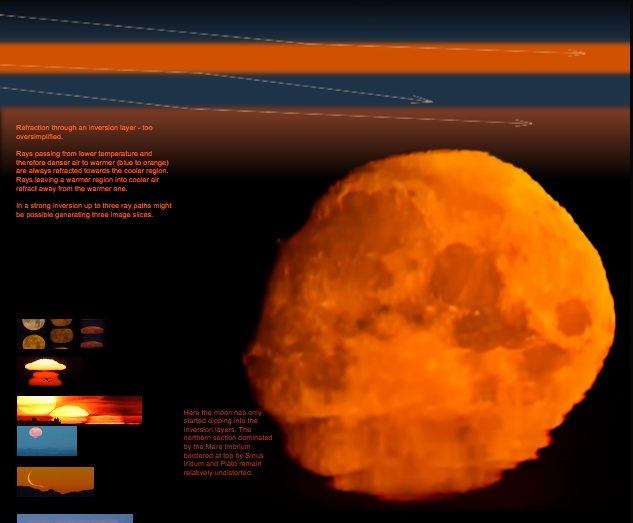XXXX - OPOD
XXXX - OPOD: Understanding Atmospheric Optics
Atmospheric optics is a fascinating field of study that explores the various optical phenomena that occur in the Earth's atmosphere. One such phenomenon is known as refraction, which occurs when light passes through different layers of air with varying temperatures and densities. This can lead to stunning visual effects, as demonstrated in the images captured by Doug Short in Anchorage, Alaska.
In these images, we can observe the moon passing through a distorting layer of stacked temperature inversions. Temperature inversions are atmospheric conditions where the normal decrease in temperature with increasing altitude is reversed, resulting in a layer of colder air below warmer air. These inversions can create a complex environment for light rays to traverse, leading to refraction and the distortion of celestial objects.
When light rays pass from a lower temperature and denser air to warmer air, they are refracted towards the cooler region. Conversely, when light rays pass from a warmer region into cooler air, they refract away from the warmer one. This refraction can cause the moon's features to appear shifted or even broken into slices, as seen in the images captured by Doug Short.
In cases where there is a strong inversion, multiple ray paths can be generated, resulting in multiple image slices. This phenomenon occurs when the moon is partially immersed in the inversion layers, as depicted in one of the images. The northern section of the moon, which includes prominent features like Mare Imbrium, Sinus Iridum, and Plato, remains relatively undistorted compared to other areas.
Understanding these atmospheric optics phenomena requires a deep knowledge of the properties of light and how it interacts with the atmosphere. Scientists and researchers study these phenomena to gain insights into the behavior of light in different atmospheric conditions. This knowledge can also be applied to other celestial objects and atmospheric phenomena, such as mirages, halos, and rainbows.
Atmospheric optics not only provides a captivating visual experience but also serves as a reminder of the complexity and beauty of our atmosphere. By studying and appreciating these phenomena, we can gain a deeper understanding of the intricate workings of our planet's atmosphere and the impact it has on the light that surrounds us.
In conclusion, atmospheric optics is a field of study that explores the fascinating optical phenomena that occur in our atmosphere. Through the phenomenon of refraction, light rays passing through different temperature and density regions can create stunning visual effects, as demonstrated by the images captured by Doug Short. Understanding these phenomena requires a deep knowledge of light and its interaction with the atmosphere. By studying atmospheric optics, we can gain insights into the behavior of light in different atmospheric conditions and appreciate the complexity and beauty of our atmosphere.

Moonset, Anchorage, Alaska ~ Doug Short imaged for eight minutes on February 19, ‘16. The moon passes through a distorting layer of stacked - but minor - temperature inversions. Cold air below warmer. Rays crossed between different temperature and density regions. They refracted, shifting lunar features out of place, even breaking the moon into pancake slices. Finally the upper limb shows a strong green rim. Almost, but not quite, a green flash. All images ©Doug Short, shown with permission


Refraction through an inversion layer - too oversimplified.
Rays passing from lower temperature and therefore denser air to warmer (blue to orange) are always refracted towards the cooler region. Rays leaving a warmer region into cooler air refract away from the warmer one.
In a strong inversion up to three ray paths might be possible generating three image slices.
Here the moon has only started dipping into the inversion layers. The northern section dominated by the Mare Imbrium bordered at top by Sinus Iridum and Plato remain relatively undistorted.
Note: this article has been automatically converted from the old site and may not appear as intended. You can find the original article here.
Reference Atmospheric Optics
If you use any of the definitions, information, or data presented on Atmospheric Optics, please copy the link or reference below to properly credit us as the reference source. Thank you!
-
<a href="https://atoptics.co.uk/blog/xxxx-opod-2/">XXXX - OPOD</a>
-
"XXXX - OPOD". Atmospheric Optics. Accessed on December 24, 2024. https://atoptics.co.uk/blog/xxxx-opod-2/.
-
"XXXX - OPOD". Atmospheric Optics, https://atoptics.co.uk/blog/xxxx-opod-2/. Accessed 24 December, 2024
-
XXXX - OPOD. Atmospheric Optics. Retrieved from https://atoptics.co.uk/blog/xxxx-opod-2/.